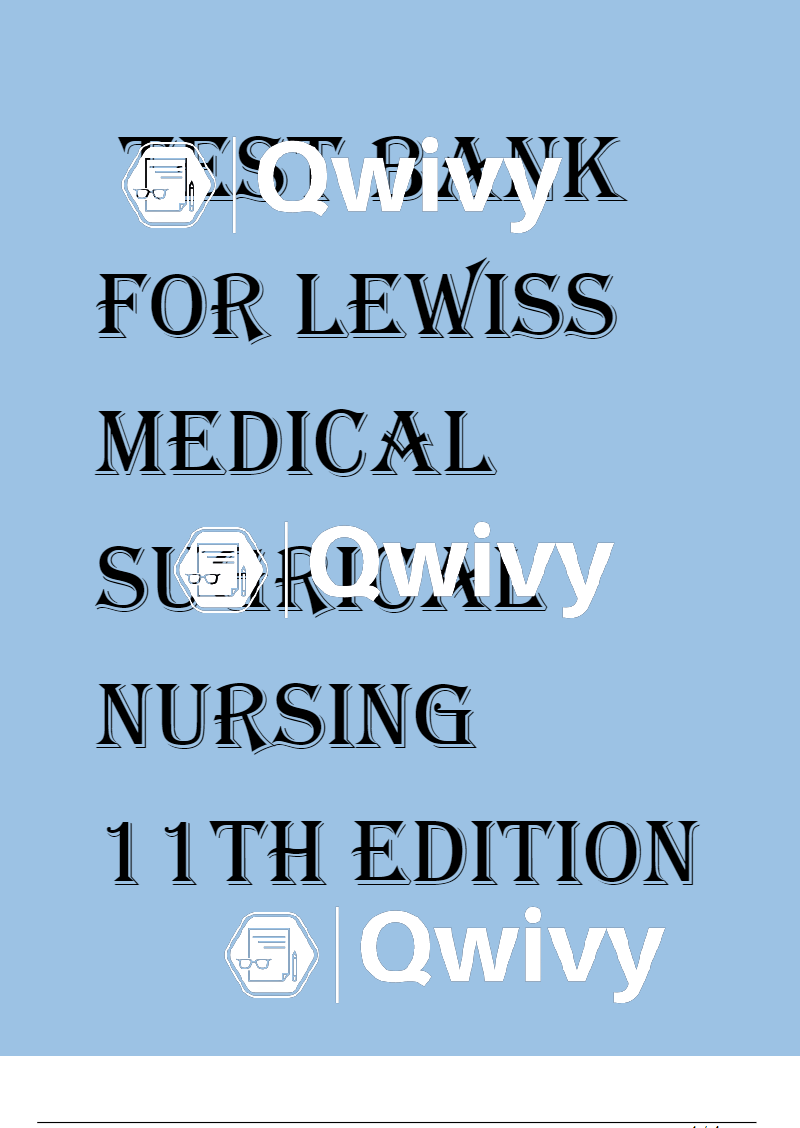
lOMoARcPSD|635 392 0
Principles of Anatomy and Physiology 14th Edition Tortora
Test Bank
Human Anatomy and Physiology (Athabasca University)
1 / 4
lOMoARcPSD|635 392 0
Principles of Anatomy and Physiology, 14th Edition Tortora Test Bank
Package Title: Testbank
Course Title: PAP 14
Chapter Number: 03
Question type: Multiple Choice
1) What are the three main parts of a eukaryotic cell?
a) plasma membrane, organelles, cytoplasm
b) plasma membrane, organelles, nucleus
c) plasma membrane, cytoplasm, organelles
d) plasma membrane, cytoplasm, nucleus
e) plasma membrane, cytosol, organelles
Answer: d
Difficulty: Medium
Study Objective 1: SO 3.1 Name and describe the three main parts of a cell.
Section Reference 1: Sec 3.1 Parts of a Cell
Question type: Essay
2) Briefly describe the fluid mosaic model.
Answer:
Difficulty: Medium
Study Objective 1: SO 3.2 Describe the structure and functions of the plasma membrane.
Section Reference 1: Sec 3.2 The Plasma Membrane
2 / 4
lOMoARcPSD|635 392 0
Solution: The fluid mosaic model states that the molecular arrangement of the plasma membrane
resembles an ever-moving sea of fluid lipids containing a mosaic of many different proteins.
Question type: Multiple Choice
3) The three main components of the lipid bilayer portion of a plasma membrane are
a) phospholipids, glycoproteins, and water.
b) proteins, cholesterol, and fatty acids.
c) cholesterol, triglycerides, and glycolipids.
d) phospholipids, cholesterol, and glycolipids.
e) phospholipids, cholesterol, and proteins.
Answer: d
Difficulty: Medium
Study Objective 1: SO 3.2 Describe the structure and functions of the plasma membrane.
Study Objective 2: SO 3.2.2 Explain the concept of selective permeability.
Section Reference 1: Sec 3.2 The Plasma Membrane
4) What are the nonpolar parts of phospholipids?
a) phosphate-containing head groups
b) fatty acid tail groups
c) Both the head and tail groups are nonpolar.
d) Neither the head nor tail groups are nonpolar.
Answer: b
Difficulty: Medium
Study Objective 1: SO 3.2 Describe the structure and functions of the plasma membrane.
Study Objective 2: SO 3.2.2 Explain the concept of selective permeability.
Section Reference 1: Sec 3.2 The Plasma Membrane
5) The polar portion of a cholesterol molecule, which forms hydrogen bonds with the polar heads
of neighboring phospholipids and glycolipids, consists of a
a) –OH group.
b) –CH3 group.
c) –CH4 group
d) –COOH group
e) None of these choices is correct.
3 / 4
lOMoARcPSD|635 392 0
Answer: a
Difficulty: Hard
Study Objective 1: SO 3.2 Describe the structure and functions of the plasma membrane.
Study Objective 2: SO 3.2.2 Explain the concept of selective permeability.
Section Reference 1: Sec 3.2 The Plasma Membrane
6) This type of membrane protein extends across the entire lipid bilayer of the plasma membrane
touching both intracellular fluid and the extracellular fluid.
a) complement protein
b) transmembrane protein
c) peripheral protein
d) lipoprotein
e) All of these choices are correct.
Answer: b
Difficulty: Medium
Study Objective 1: SO 3.2 Describe the structure and functions of the plasma membrane.
Study Objective 2: SO 3.2.2 Explain the concept of selective permeability.
Section Reference 1: Sec 3.2 The Plasma Membrane
Question type: Essay
7) Describe five different functions of integral membrane proteins.
Answer:
Difficulty: Hard
Study Objective 1: SO 3.2 Describe the structure and functions of the plasma membrane.
Study Objective 2: SO 3.2.2 Explain the concept of selective permeability.
Section Reference 1: Sec 3.2 The Plasma Membrane
Solution: Some membrane proteins act as ion channels or carriers that transport substances across
the membrane. Other membrane proteins act as receptors that allow the cell to respond to various
types of ligands. Other membrane proteins are enzymes that catalyze specific chemical reactions.
Still other membrane proteins act as linker proteins that anchor cells to neighboring structures
including other cells. Lastly, some membrane proteins serve as cell identity molecules.
Question type: Multiple Choice
Powered by qwivy(www.qwivy.org)
4 / 4
| Category | TEST BANK |
| Pages | 748 |
| Language | English |
| Comments | 0 |
| Sales | 0 |









{{ userMessage }}





